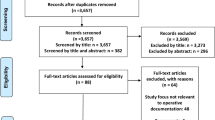Abstract
Background
Limited evidence exists describing the optimum protocol for intraoperative cholangiography (IOC) during laparoscopic cholecystectomy (LC). Images saved during surgery often fail to highlight the necessary anatomical landmarks and documentation is variable. Our aim was to identify the key characteristics of an optimal IOC and evaluate current practice at our institution.
Methods
A literature search identified quality indicators for performing IOC and documenting key findings. A standardised proforma for scoring IOC was developed. Retrospective analysis was conducted of consecutive IOCs performed during elective LC. Visual documentation of seven anatomical landmarks on the captured IOC images and textual reporting in the operation note were assessed.
Results
One hundred IOCs were evaluated. Only 32 (34%) of captured images had all 7 landmarks present. All cases failed to document all seven landmarks. There was a significant difference between landmarks that could be identified on the captured images and their documentation.
Conclusions
This study suggests that IOC image capture of the key seven landmarks and their textual reporting in this cohort is sub-optimal. We believe IOC technique, minimal data set for reporting and image capture should be standardised to allow better communication of findings and facilitate meaningful comparative research relating to the subject.




Similar content being viewed by others
References
Morgenstern L (1992) Carl Langenbuch and the first cholecystectomy. Surg Endosc 6(3):113–114
Olsen D (1997) Bile duct injuries during laparoscopic cholecystectomy. Surg Endosc 11(2):133–138
Servetus M, O'Malley CD, Fulton JF (1989) Christianismi restitutio and other writings: as translated by Charles Donald O'Malley, with commentary by John F. Fulton. The Classics of Medicine Library
Gadacz TR, Talamini MA, Lillemoe KD, Yeo CJ (1990) Laparoscopic cholecystectomy. Surg Clin North Am 70(6):1249–1262
Rystedt JML, Wiss J, Adolfsson J, Enochsson L, Hallerback B, Johansson P et al (2021) Routine versus selective intraoperative cholangiography during cholecystectomy: systematic review, meta-analysis and health economic model analysis of iatrogenic bile duct injury. BJS Open. https://doi.org/10.1093/bjsopen/zraa032
Tornqvist B, Stromberg C, Persson G, Nilsson M (2012) Effect of intended intraoperative cholangiography and early detection of bile duct injury on survival after cholecystectomy: population based cohort study. BMJ 345:e6457. https://doi.org/10.1136/bmj.e6457
Mortele KJ, Ros PR (2001) Anatomic variants of the biliary tree: MR cholangiographic findings and clinical applications. AJR Am J Roentgenol 177(2):389–394. https://doi.org/10.2214/ajr.177.2.1770389
Cucchetti A, Peri E, Cescon M, Zanello M, Ercolani G, Zanfi C et al (2011) Anatomic variations of intrahepatic bile ducts in a European series and meta-analysis of the literature. J Gastrointest Surg Tract 15(4):623–630. https://doi.org/10.1007/s11605-011-1447-4
Choi JW, Kim TK, Kim KW, Kim AY, Kim PN, Ha HK et al (2003) Anatomic variation in intrahepatic bile ducts: an analysis of intraoperative cholangiograms in 300 consecutive donors for living donor liver transplantation. Korean J Radiol 4(2):85–90. https://doi.org/10.3348/kjr.2003.4.2.85
Sugrue WJ, Stewart RJ, Pascoe DL, Macbeth WA (1977) Operative cholangiography in two hundred consecutive cholecystectomies. N Z Med J 86(600):470–471
Rolfsmeyer ES, Bubrick MP, Kollitz PR, Onstad GR, Hitchcock CR (1982) The value of operative cholangiography. Surg Gynecol Obstet 154(3):369–371
Corlette MB Jr, Schatzki S, Ackroyd F (1978) Operative cholangiography and overlooked stones. Arch Surg 113(6):729–734
Hall RC, Sakiyalak P, Kim SK, Rogers LS, Webb WR (1973) Failure of operative cholangiography to prevent retained common duct stones. Am J Surg 125(1):51–63
Ashmore JD, Kane JJ, Pettit HS, Mayo HW Jr (1956) Experimental evaluation of operative cholangiography in relation to calculus size. Surgery 40(1):191–196
Machi J, Sigel B, Spigos DG, Beitler JC, Justin JR (1983) Critical factors in the image clarity of operative cholangiography. J Surg Res 35(6):480–489
Hur KB, Park YO, Rice RG, Min KS (1972) Use of a dye-dilution technic to demonstrate biliary calculi in the operative cholangiogram. Ann Surg 176(5):663–668
Hur KB, Rice RG, Hong SS (1963) Cholelithiasis in Koreans. Yonsei Med J 4:103–118. https://doi.org/10.3349/ymj.1963.4.1.103
Roy PG, Soonawalla ZF, Grant HW (2009) Medicolegal costs of bile duct injuries incurred during laparoscopic cholecystectomy. HPB (Oxford) 11(2):130–134. https://doi.org/10.1111/j.1477-2574.2008.00023.x
Funding
No grant support was received.
Author information
Authors and Affiliations
Corresponding author
Ethics declarations
Disclosures
Rebecca E Barnett, Yousef Ibrahim, James Ansell, Rhys Thomas, Kimberly Da Costa and Ashraf Rasheed have no conflicts of interest or financial ties to disclose.
Additional information
Publisher's Note
Springer Nature remains neutral with regard to jurisdictional claims in published maps and institutional affiliations.
Rights and permissions
About this article
Cite this article
Barnett, R.E., Ibrahim, Y., Ansell, J. et al. Optimal technique for intraoperative cholangiography (IOC) and are the technique and the findings optimally recorded at our institution?. Surg Endosc 36, 8784–8789 (2022). https://doi.org/10.1007/s00464-022-09301-y
Received:
Accepted:
Published:
Issue Date:
DOI: https://doi.org/10.1007/s00464-022-09301-y




